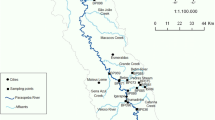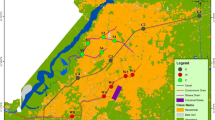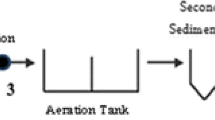Abstract
Goal, scope, and background
The xenoestrogens bisphenol A, 4-tert-octylphenol, and the technical isomer mixture of 4-nonylphenol (tech. 4-nonylphenol) belong to the group of chemicals which are called endocrine disrupters due to their property of causing hormonal dysfunctions in the endocrine system of organisms at very low concentrations. Bisphenol A, 4-tert-octylphenol, and the tech. 4-nonylphenol (mixture of isomers) were determined in water samples collected from the influent and effluent of two German wastewater treatment plants (WWTP) during a long-time sampling period from February 2003 till August 2005 to assess their occurrence and temporal variations in WWTPs.
Methods
The compounds were extracted and concentrated from water by solid-phase extraction (SPE) using Bond Elut PPL cartridges and quantified by use of gas chromatography–mass spectrometry (GC–MS).
Results
The influent concentrations were as follows: Bisphenol A < limit of detection of the method (< ldm)—12,205 ng L−1, tech. 4-nonylphenol < ldm—10,186 ng L−1, and 4-tert-octylphenol 39—1,495 ng L−1. The measured effluent concentrations were lower with values in the range of < ldm—7,625 ng L−1 for bisphenol A, < ldm—14,444 ng L−1 for tech. 4-nonylphenol, and < ldm—392 ng L−1 for 4-tert-octylphenol. All target compounds were largely eliminated during the wastewater treatment process. The elimination efficiency varied between 73% and 93%.
Discussion
All analytes show highly fluctuating influent concentrations with very high peak concentrations at particular sampling times. The variation of effluent concentrations is by far lower than the variation of influent concentrations. For tech. 4-nonylphenol, a significant temporal concentration variation has been detected with very high concentrations up to the microgram-per-liter level in the time from February 2003 till July 2003 and clearly decreasing concentrations in the time from June 2004 till August 2005. This corresponds well with the implementation of Directive 2003/53/EC (nonylphenol and nonylphenol ethoxylates in the European Union “may not be placed on the marked or used as a substance or constituent of preparations in concentrations equal or higher than 0.1% by mass”) from January 2005 on. Bisphenol A is present in the effluent samples in a wide range of concentrations from below the detection limit to high concentrations up to the microgram-per-liter level. For 4-tert-octylphenol, no particular trend of concentration development has been observed.
Conclusions
Combined SPE and GC–MS proved to be an efficient method to identify and quantify polar organic compounds in environmental samples. With respect to the concentrations measured in the present study, bisphenol A sometimes is the prominent compound in influent samples. Neither bisphenol A nor 4-tert-octylphenol or tech. 4-nonylphenol show seasonal variations. However, there was a significant general trend of decreasing concentrations of tech. 4-nonylphenol in influent and effluent samples from both WWTPs which probably reflects the implementing Directive 2003/53/EC.
Recommendations and perspectives
Further research is needed to investigate whether the observed decrease of tech. 4-nonylphenol concentrations in German WWTPs since June 2004 will continue further on. The reason for the high effluent concentrations of bisphenol A in only a few samples has to be clarified in further research. The results from this study provide insight into the concentration development of the xenoestrogens bisphenol A, tech. 4-nonylphenol, and 4-tert-octylphenol in WWTPs in the time span between 2003 and 2005.




Similar content being viewed by others
References
Ahel M, Giger W (1993) Partitioning of alkylphenols and alkylphenol polyethoxylates between water and organic solvents. Chemosphere 26:1471–1478
Belfroid A, van Velzen M, van der Horst B, Vethaak D (2002) Occurrence of bisphenol A in surface water and uptake in fish: evaluation of field measurements. Chemosphere 49:97–103
Bennie DT (1999) Review of the environmental occurrence of alkylphenols and alkylphenol ethoxylates. Water Qual Res J Canada 34:79–122
Bolz U, Hagenmaier H, Körner W (2001) Phenolic xenoestrogens in surface water, sediments and sewage sludge from Baden–Württemberg, south–west Germany. Environ Pollut 115:291–301
BUA (1997) BUA—Stoffbericht 203. S. Hirtzel Wissenschaftliche Verlagsgesellschaft, Stuttgart
Céspedes R, Lacorte S, Raldua D, Ginebreda A, Barceló D, Piña B (2005) Distribution of endocrine disruptors in the Llobregat River basin (Catalonia, NE Spain). Chemosphere 61:1710–1719
EC (2003) Directive 2003/53/EC of the European Parliament and of the council of 18 June
EU (2002) European Union Risk assessment report of 4-nonylphenol (branched) and nonylphenol risk assessment, CAS Nos 84852-15-2 and 25154-52-3, 2nd priority list, Vol. 10
EU (2003) European Union risk assessment report of 4,4’-isopropylidenediphenol (bisphenol-A), CAS No 80-05-7, 3rd priority list, Vol. 37
Fahlenkamp H, Spiteller M, Zühlke S (2007) Untersuchung zum Eintrag und zur Elimination von gefährlichen Stoffen in kommunalen Kläranlagen. http://www.infu.tu-dortmund.de/Projekte/Klaeranlagen
Fries E, Püttmann W (2003) Occurrence and behaviour of 4-nonylphenol in river water of Germany. J Environ Monit 5:598–603
Fromme H, Küchler T, Otto T, Pilz K, Müller J, Wenzel A (2002) Occurrence of phthalates and bisphenol A and F in the environment. Water Res 36:1429–1438
Fürhacker M, Scharf S, Weber H (2000) Bisphenol A: emissions from point sources. Chemosphere 41:751–756
Gehring M (2004) Beiträge zu Abfallwirtschaft und Altlasten, Schriftenreihe des Institutes für Abfallwirtschaft und Altlasten der Technischen Universität Dresden, S. 34
Global Industry Group (2004) Bisphenol A. http://www.bisphenol-a.org/about/faq.html#c. Accessed 31 October 2005
Gülden M, Turan A, Seibert H (1998) Texte 66, Research Report 102 04 279. Federal Environmental Agency, Berlin.
Heemken OP, Reincke H, Stachel B, Theobald N (2001) The occurrence of xenoestrogens in the Elbe river and the North Sea. Chemosphere 45:245–259
Hegemann W, Busch K, Spengler P, Metzger JW (2002) Einfluss der Verfahrenstechnik auf die Eliminierung ausgewählter Estrogene und Xenoestrogene in Kläranlagen—Ein BMBF-Verbundprojekt. Ergebnis von Stufenbeprobungen auf kommunalen Kläranlagen. GWF Wasser/Abwasser 143(5):422–428
Hollert H, Durr M, Holtey-Weber R, Islinger M, Brack W, Farber H, Erdinger L, Braunbeck T (2005) Endocrine disruption of water and sediment extracts in a non-radioactive dot blot/RNAse protection-assay using isolated hepatocytes of rainbow trout—deficiencies between bioanalytical effectiveness and chemically determined concentrations and how to explain them. Env Sci Pollut Res 12:347–360
Isobe T, Nishiyama H, Nakashima A, Takada H (2001) Distribution and behavior of nonylphenol, octylphenol and nonylphenol monoethoxylate in Tokyo metropolitan area: their association with aquatic particles and sedimentary distribution. Environ Sci Technol 35:1041–1049
Jiang JQ, Yin Q, Zhou JL, Pearce P (2005) Occurrence and treatment trials of endocrine disrupting chemicals (EDCs) in wastewaters. Chemosphere 61:544–550
Jin X, Jiang G, Huang G, Liu J, Zhou Q (2004) Determination of 4-tert-octylphenol, 4-nonylphenol and bisphenol A in surface waters from the Haihe River in Tianjin by gas chromatography–mass spectrometry with selected ion monitoring. Chemosphere 56:1113–1119
Kolpin DW, Skopec M, Meyer MT Furlong ET, Zaugg SD (2004) Urban contribution of pharmaceuticals and other organic wastewater contaminants to streams during differing flow conditions. Sci Total Environ 328:119–130
Kuch HM, Ballschmiter K (2001) Determination of endocrine-disrupting phenolic compounds and estrogens in surface and drinking water by HRGC-(NCI)-MS in the picogram per liter range. Environ Sci Technol 35:3201–3206
Leisewitz A, Schwarz W (1997) Stoffströme wichtiger endokrin wirksamer Industriechemikalien (Bisphenol A, Dibutylphthalat/Benzylbutylphthalat, Nonylphenol/Alkylphenolethoxylate). Öko-Recherche Büro für Umweltforschung und –beratung GmbH, Frankfurt/Main im Auftrag des Umweltbundesamtes, Forschungsbericht 10601076
Leisewitz A, Seel P, Fengler S (2003) Orientierende Messungen gefährlicher Stoffe. Landesweite Untersuchungen auf organische Spurenverunreinigungen in hessischen Fließgewässern, Abwässern und Klärschlämmen 1991–2001. Ergänzender Bericht zu 1999–2001. Hessisches Landesamt für Umwelt und Geologie, Wiesbaden
Li D, Kim M, Shim WJ, Yim UH, Oh J-R, Kwon Y-J (2004) Seasonal flux of nonylphenol in Han River, Korea. Chemosphere 56:1–6
Miyamoto J, Klein W (1998) Natural and anthropogenic environmental oestrogens: the scientific basis for risk assessment. Environmental exposure, species differences and risk assessment. Pure Appl Chem 70:1829–1845
Pedersen RT, Hill EM (2002) Tissue distribution and depuration of 4-tert-octylphenol residues in the Cyprinid fish, Scardinius erythrophthalmus. Environ Sci Technol 36:3275–3283
Rastall AC, Getting D, Goddard J, Roberts DR, Erdinger L (2006) A biomimetic approach to the detection and identification of estrogen receptor agonists in surface waters using semipermeable membrane devices (SPMDs) and bioassay-directed chemical analysis. Env Sci Pollut Res 13:256–267
Rudel RA, Melly SJ, Geno PW, Sun G, Brody JG (1998) Identification of alkylphenols and other estrogenic phenolic compounds in wastewater, seepage, and groundwater on Cape Cod, Massachusetts. Environ Sci Technol 32:861–869
Spengler P, Scholz-Muramatsu H, Gaiser S, Metzger JW (2003) Verbleib ausgewählter Xenoöstrogene in der Kläranlage. GWF Wasser/Abwasser 144(4):284–291
Stachel B, Ehrhorn U, Heemken O-P, Lepom P, Reincke H, Sawal G, Theobald N (2003) Xenoestrogens in the Elbe River and its tributaries. Environ Pollut 124:497–507
Staples CA, Dorn PB, Klecka GM, O'Block ST, Harris LR (1998) A review of the environmental fate, effects, and exposures of bisphenol A. Chemosphere 36:2149–2173
Staples CA, Dorn PB, Klecka GM, O'Block ST, Branson DR, Harris LR (2000) Bisphenol A concentrations in receiving waters near US manufacturing and processing facilities. Chemosphere 40:521–525
The International Program on Chemical Safety (IPCS) (2005) http://www.who.int/ipcs/publications/new_issues/endocrine_disruptors/en/. Accessed 02 November 2005
The International Program on Chemical Safety (IPCS) (2006) Phenol, 4-(1,1,3,3-tetramethylbutyl). SIDS Initial Assessment Report, http://www.inchem.org/documents/sids/sids/140669.pdf. Accessed 25 January 2006
Tsuda T, Takino A, Kojima M, Harada H, Muraki K, Tsuji M (2000) 4-Nonylphenols and 4-tert-octylphenol in fish from rivers flowing into Lake Biwa. Chemosphere 41:757–762
Voutsa D, Hartmann P, Schaffner C, Giger W (2006) Benzotriazoles, alkylphenols and bisphenol a in municipal wastewaters and in the Glatt River, Switzerland. Env Sci Pollut Res 13:333–341
Wenzel A, Böhmer W, Müller J, Rüdel H, Schröter-Kermani C (2004) Retrospective monitoring of alkylphenols and alkylphenol monoethoxylates in Aquatic Biota from 1985 to 2001: results from the German environmental specimen bank. Environ Sci Technol 38:1654–1661
Wichmann H, Sprenger R, Ehlers N, Bahadir MA (2005) Analytical investigations on a releasing agent application in aluminium die casting. Env Sci Pollut Res 12:227–232
Yamamoto T, Yasuhara A, Shiraishi H, Nakasugi O (2001) Bisphenol A in hazardous waste landfill leachates. Chemosphere 42:415–418
Acknowledgment
We acknowledge support from Dr. S. Schmid from Stadtentwässerung Frankfurt am Main by providing information on the technical function of the wastewater treatment plants which were sampled in the present study. Thanks also go to H. Schneider from Stadtentwässerung Frankfurt am Main for providing the samples. This study was carried out within the frame of the MOMUS-Project; financial support by Hessisches Ministerum für Wissenschaft und Kunst is gratefully acknowledged.
Author information
Authors and Affiliations
Corresponding author
Additional information
Responsible editor: Andreas Gies
Rights and permissions
About this article
Cite this article
Höhne, C., Püttmann, W. Occurrence and temporal variations of the xenoestrogens bisphenol A, 4-tert-octylphenol, and tech. 4-nonylphenol in two German wastewater treatment plants. Environ Sci Pollut Res 15, 405–416 (2008). https://doi.org/10.1007/s11356-008-0007-2
Received:
Accepted:
Published:
Issue Date:
DOI: https://doi.org/10.1007/s11356-008-0007-2




